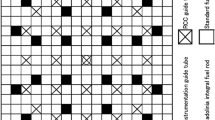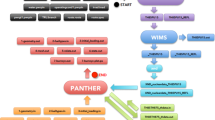Abstract
To increase the cycle burnup of a PWR fuel assembly, different burnable poisons (BPs) are evaluated. A new innovative neutron absorber based on polymer composition is proposed. Assembly level fuel burnup calculations are performed up to 60 GWd/MTU of heavy metal. The effect of the replacement of CrB2Al BP by polycarborane-siloxane-ethynyl (PACS) polymer in the WWER-1000 nuclear reactor is analyzed. The main neutronic parameters including burnup reactivity, maximum pin power variation versus burnup, pin power distribution, cycle length, and reactivity swing are calculated. In addition, the primary safety parameters, including fuel and moderator temperature coefficients, are evaluated to check the effectiveness of the new proposed BP. The results were promising. The highest cycle length, 18.267 GWd/MTU is obtained by the proposed PACS BP. The suggested polymeric BP also favors the lowest reactivity swing, 3365 pcm, while no considerable increase in pin power peaking is observed. It is also shown that the fuel assembly with PACS case provides maximum pin power peaking of 1.111 (~ 3% higher than the unpoisoned case) at beginning of cycle (BOC) and 1.097 (~ 0.4% lower than the unpoisoned case) at EOC, respectively. Furthermore, the fuel temperature coefficient, FTC, and the moderator temperature coefficient, MTC, of the PACS BP result in more negative values and thus can provide better behavior (controllability) during accidents.


















Similar content being viewed by others
Data availability
This manuscript has associated data in a data repository. [Authors’ comment: The data that support the findings of this study are available on request from the corresponding author.]. However, To the best of the authors’ knowledge, this paper and references herein contain all the data needed to reproduce and validate the results presented.
References
H.N. Tran, V.K. Hoang, P.H. Liem, H.T. Hoang, Neutronics design of VVER-1000 fuel assembly with burnable poison particles. Nucl. Eng. Technol. 51(2019), 1729–1737 (2019)
J. Choe, H.C. Shin, D. Lee, New burnable absorber for long-cycle low boron operation of PWRs. Ann. Nucl. Energy 88, 272–279 (2016)
A.A. Galahom, Study of the possibility of using Europium and Pyrex alloy as burnable absorber in PWR. Ann. Nucl. Energy 110, 1127–1133 (2017)
Z. Papi, F. Khoshahval, R. Pour-Imani, Advanced fuel and burnable absorbers designed for long-cycle operation of BNPP. Radiat. Phys. Chem. 206, 110796 (2023)
M.S. Yahya, Y. Kim, An innovative core design for a soluble boron free small pressurized water reactor. Int. J. Energy Res. 42, 73–81 (2018)
O.I. Aguilar, Fuel Loading for a Low-Leakage Core in a Pressurized Water Reactor (1986). Masters Theses. 390
J.R. Lamarsh, A.J. Baratta, Introduction to Nuclear Engineering (Prentice Hall, New Jersey, 2001)
W.T. Loh, M.J. Driscoll, D.D. Lanning, The use of burnable poison to improve uranium utilization in PWRs (1982)
U.M. Nabila, M.H. Sahadath, Neutronic and fuel cycle performance of LEU fuel with different means of excess reactivity control: impact of neutron leakage and refueling scheme. Ann. Nucl. Energy 175, 109245 (2022)
F. Khoshahval, S.S. Foroutan, A. Zolfaghari, H. Minuchehr, Evaluation of burnable absorber rods effect on neutronic performance in fuel assembly of WWER-1000 reactor. Ann. Nucl. Energy 87, 648–658 (2016)
E.H. Uguru, S.F.A. Sani, M.U. Khandaker, M.H. Rabir, J.A. Karim, A comparative study on the impact of Gd2O3 burnable neutron absorber in UO2 and (U, Th)O2 fuels. Nucl. Eng. Technol. 52, 1099–1109 (2020). https://doi.org/10.1016/j.net.2019.11.010
F. Franceschini, B. Petrovic, Fuel with advanced burnable absorbers design for the IRIS reactor core: combined Erbia and IFBA Ann. Nucl. Energy 36(1201), 1207 (2009). https://doi.org/10.1016/j.anucene.2009.04.005
L. Heraltova, Influence of gadolinium burnable absorber to optimization of VVER-440 fuel assembly design. in Proceedings of the 13th international scientific conference EPE, Czech Republic (2012). pp. 1293–1298.
F. Khoshahval, The effect of enriched gadolinia and its concentrations on the neutronic parameters of AP-1000 fuel assembly. Radiat. Phys. Chem. 195, 110086 (2022). https://doi.org/10.1016/j.radphyschem.2022.110086
K.H. Bejmer, O. Seveborn, Enriched gadolinium as burnable absorber for PWR. in Proc. PHYSOR Phys. Fuel Cycles Adv. Nucl. Syst. Glob. Dev (2004)
S. Yilmaz, K. Ivanov, S. Levine, M. Mahgerefteh, Development of enriched Gd-155 and Gd-157 burnable poison designs for a PWR core. Ann. Nucl. Energy 33, 439–445 (2006). https://doi.org/10.1016/j.anucene.2005.11.011
Md.T. Hossain, Md.H. Sahadath, U.M. Nabila, Neutronic and fuel cycle performance of VVER-1000 for dual cooled fuel with coated burnable poisons. Prog. Nucl. Energy 145(2022), 104139 (2022)
S. Xu, T. Yu, J. Xie, L. Yao, Z. Li, Burnable poison selection and neutronics analysis of plate fuel assemblies. Front. Energy Res. 9, 729552 (2021). https://doi.org/10.3389/fenrg.2021.729552
K.S. Allen, Advanced Polymeric Burnable Poison Rod Assemblies for Pressurized Water Reactors (Doctoral dissertation, University of Florida, 2003)
Final Safety Analysis Report of BNPP-1, 2003. Chapter 4, Reactor, 49.BU.10.0.OO. FSAR. RDR001
G. Marleau, A. Hebert, R. Roy, A user guide for dragon version 4. Technical Report IGE-294. École Polytechnique de Montréal (2016)
S. Liu, J. Cai, Neutronic and thermohydraulic characteristics of a new breeding thorium–uranium mixed SCWR fuel assembly. Ann. Nucl. Energy 62, 429–436 (2013). https://doi.org/10.1016/j.anucene.2013.07.004
A. Naceur, G. Marleau, Neutronic analysis for accident tolerant cladding candidates in CANDU-6 reactors. Ann. Nucl. Energy 113, 147–161 (2018)
P.K. Romano, N.E. Horelik, B.R. Herman, A.G. Nelson, B. Forget, K. Smith, OpenMC: a state-of-the-art Monte Carlo code for research and development. Ann. Nucl. Energy 82, 90–97 (2015). https://doi.org/10.1016/j.anucene.2014.07.048
K. Allen, R. Baney, D. Butt, An advanced burnable poison for pressurized water reactors. in Proc. Conf. Advances in Nuclear Fuel Management III (2003). pp. 5–8
Keller TM, Son DY. Linear “carborane”: (Siloxane or silane)—acetylene based co-polymers. US Patent 5,780,569 (1998)
M.J. Bolukbasi, S.C. Middleburgh, M. Dahlfors, W.E. Lee, Performance and economic assessment of enriched gadolinia burnable absorbers. Prog. Nucl. Energy 137(2021), 103752 (2021)
M.I.K. Santala, A.S. Daavittila, H.M. Lauranto, R.R.E. Salomaa, Odd-isotope enrichment studies of Gd by double resonance laser-ionization for the production of burnable nuclear reactor poison. Appl. Phys. B Laser Opt. 64, 339–347 (1997). https://doi.org/10.1007/s003400050182
C.E. Sanders, J.C. Wagner, Study of the Effect of Integral Burnable Absorbers for PWR Burnup Credit. Oak Ridge National Laboratory. NUREG/CR-6760 (2002)
A.I. Soldatov, Design and Analysis of a Nuclear Reactor Core for Innovative Small Light Water Reactors (Oregon State University, 2009)
W.K. Compton, Impact of configuration variations on small modular reactor core performance. A thesis presented to the faculty of the graduate school of the Missouri university of science and technology in Partial fulfillment of the requirements for the degree Master of science in nuclear engineering (2015)
C. Housiadas, M. Antonopoulos-Domis, Estimation of the moderator temperature coefficient of reactivity via noise analysis using closed-loop transfer functions. Ann. Nucl. Energy 28(10), 983–991 (2001)
Author information
Authors and Affiliations
Corresponding author
Ethics declarations
Conflict of interest
The authors declare that they have no known competing financial interests or personal relationships that could have appeared to influence the work reported in this paper.
Rights and permissions
Springer Nature or its licensor (e.g. a society or other partner) holds exclusive rights to this article under a publishing agreement with the author(s) or other rightsholder(s); author self-archiving of the accepted manuscript version of this article is solely governed by the terms of such publishing agreement and applicable law.
About this article
Cite this article
Khoshahval, F. Performance analysis of an advanced polymeric burnable poison for PWR fuel assembly. Eur. Phys. J. Plus 139, 73 (2024). https://doi.org/10.1140/epjp/s13360-024-04856-2
Received:
Accepted:
Published:
DOI: https://doi.org/10.1140/epjp/s13360-024-04856-2




